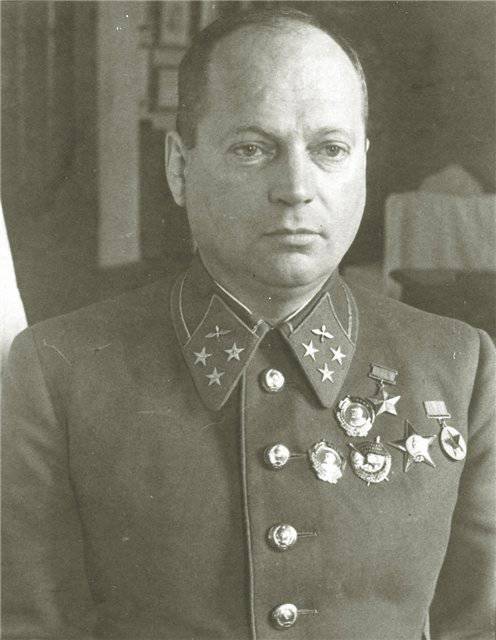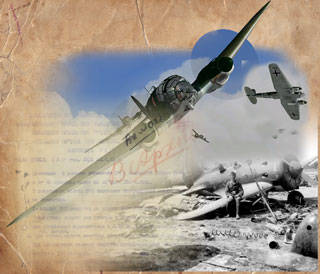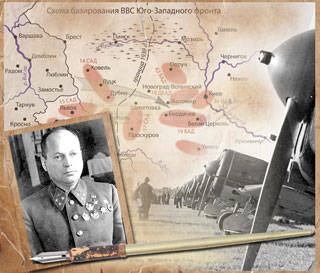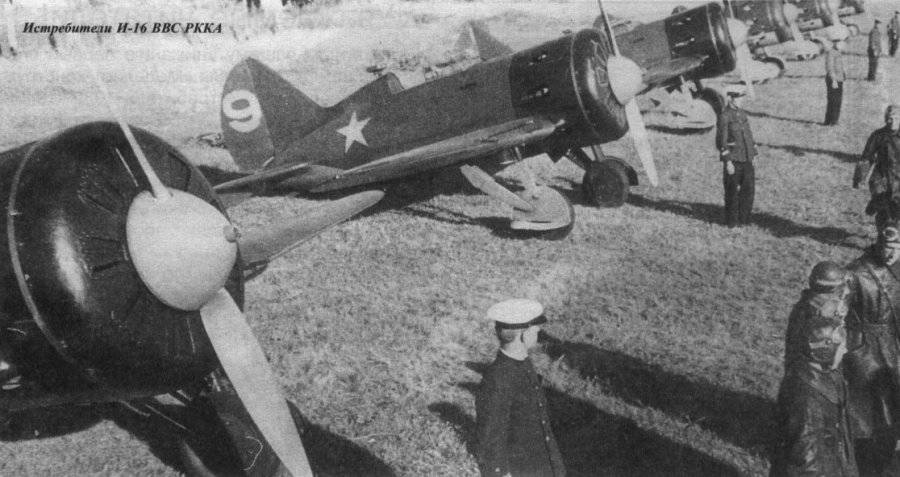"Notebook of the executed general ..."
The report of the Air Force commander of the Kiev Special Military District, Lieutenant General, has been preserved in the Central Archive of the Ministry of Defense aviation E. S. Ptukhina: “Air Force actions in offensive operations of the front and the struggle for air supremacy” (f. 131, op. 12507, d. 37). This is a rather lengthy (31 pages of typewriting) document, classified as “Owl. secret ", declassified July 31, 2009.
The date of the signing of the report is not specified, only the year is “scored” - 1940. However, judging by the fact that the German air raid on the English city of Coventry (held on the night of 14 on 15 in November of 1940 of the year) is called “the fact of the coming days”, it can be assumed that the document was drafted in November-December. It is possible that in preparation for the meeting of the top commanders of the Red Army (23 – 31 December 1940), at which the head of the Red Army’s Main Directorate, Lieutenant-General Aviation P. V. Rychagov delivered a report with exactly the same name (only without the word "front").
Combat general
In the fall of 1940, the commander of the air force of the Kiev OBO could be considered one of the most experienced commanders of Soviet aviation. In 1936, he arrived in Spain, already in the rank of brigade commander and having the experience of command of the aviation brigade behind his back. After Spain, where the commander Ptukhin not only personally shot down several rebel planes, but also served as a military adviser under the command of the Republican aviation, he becomes the commander of the air force of one of the most important military districts - Leningradsky.

During the Soviet-Finnish War, commander Ptukhin commanded the Air Force of the North-Western Front, that is, the main grouping of Soviet troops, breaking through the Mannerheim Line. Formally speaking (taking into account only the number of aircraft departures made), the actions of the NWF Air Force were the largest combat aviation operation of the first year of World War II. 21 March 1940-th Ptukhin becomes Hero of the Soviet Union, in June of the same year he was given the military rank of “Lieutenant General of Aviation”.
Here are some excerpts from his report:
l 8. This operation is the most difficult, will require maximum efforts by the Air Force and will be the most difficult in terms of losses - both materiel and personnel ...
l 9. The raid on [oil] trades should be extremely massive, thousands of aircraft should participate in this operation in order to inflict irreparable damage with one blow and break any resistance that the area’s air defense will have ...
l 10. For the destruction of industrial enterprises, it is necessary to send large aviation connections, which, with the first or in the extreme case, with the second blow, should destroy all the objects planned for destruction. The group of at least 500 bombers, since only such a massive use of aviation guarantees success ...
l 11. According to the foreign press, the production of aircraft [in Germany] reaches 1000 per month ... German combat air forces today are approaching 18-20 thousand aircraft ... Italy has air fleet consisting of at least 5 thousand combat aircraft ... It must be assumed that at least 10 thousand aircraft will be concentrated against our South-Western Front ...
l 13. In order to concentrate up to 10 thousand aircraft, [the enemy] must have at least 425 high-grade airfields, and three-quarters of them - to 300 airfields - must be located in the deployment zone of the main operations, that is, on the front in 350 – 400 km There is no exact data on whether Germany currently has so many airfields in the territory bordering KOVO ...
l 18. Before the start of artillery and aviation training, the Air Force must disorganize the enemy’s control system by acting on the headquarters and command posts, breaking (by specially adapted “cats” on the aircraft) all communications, from the front to the operational depth, to destroy all radio stations that were opened by intelligence. In the future, the Air Force should repeat such operations and prevent the restoration of communications ...
l 23. Given the technical strength of the German Air Force and the high level of training of its flight personnel, we can conclude that in order to create relative freedom of action on our front, you must have at least a half-and-a-half superiority in the air, that is, up to 15 thousand aircraft or 45 air divisions ...
l 26. The need for an airfield network:
a) “first line”, 30 – 100 km from the front line, 125 airfields for 3000 airplanes (fighters and attack aircraft);
b) “second line”, 50 – 150 km, 275 airfields for 6750 airplanes (dive-bombers, light bombers and 2-motor fighters);
c) “third line”, 100 – 150 and more than km, 220 airfields for 5250 aircraft (long-range and heavy bomber) ...
l 27. Our Air Fleet is needed in 41 – 42's. bring in the European part of the Union to 50 thousand aircraft. In subsequent years, to increase the Air Force by at least 12 – 15 thousand aircraft per year ...
l 28. It is necessary to build our Air Force for offensive operations. On this basis, I propose to have in the Air Force 35% heavy and long-range bombers, 35% medium bomber (of which half are diving), 10% 2-engine fighter, 15% single-engine fighter and 5% attack aircraft. In addition to military aviation, it is necessary to create a powerful transport aviation ... "
"Dwarfing the sky with the wings of their planes ..."
Now, having recovered our breath after a request for 50 of thousands of airplanes (and this is only “in the European part of the Union”, without taking into account the groupings in the Far East and the Caucasus!), We will try to evaluate and, if possible, understand what we read.
 In real stories The group of Soviet aviation in the theater of the 22 war year that began on June (Air Force of five districts, two fleets, and five DBA corps) consisted of about 1941 thousands of combat aircraft. If you take it hard, that is, without taking into account a large number of obsolete combat aircraft (I-8,3 fighters, TB-15 bombers), excluding the materiel of emerging air regiments, excluding transport, sanitary, training, reconnaissance aircraft. If we take them into account, and add air defense fighters of Moscow, and recall the internal air forces (Arkhangelsk, Orlovsky, Kharkiv, Privolzhsky) districts, we can count 3 – 10 thousands of aircraft “in the European part of the Union”.
In real stories The group of Soviet aviation in the theater of the 22 war year that began on June (Air Force of five districts, two fleets, and five DBA corps) consisted of about 1941 thousands of combat aircraft. If you take it hard, that is, without taking into account a large number of obsolete combat aircraft (I-8,3 fighters, TB-15 bombers), excluding the materiel of emerging air regiments, excluding transport, sanitary, training, reconnaissance aircraft. If we take them into account, and add air defense fighters of Moscow, and recall the internal air forces (Arkhangelsk, Orlovsky, Kharkiv, Privolzhsky) districts, we can count 3 – 10 thousands of aircraft “in the European part of the Union”.In an amicable way, this armada would have to be reduced, not increased. For normal combat work of already existing aircraft, there were not enough airfields, airfield equipment, trained flight and ground-technical personnel, spare parts and, most importantly, gasoline.
The gasoline crisis rapidly (as the Air Force saturates the aircraft with a new generation of aircraft engines) passed into the “gasoline catastrophe” stage.
In accordance with the mobilization request of the Red Army Air Force Command for the “1941 military year”, only combat aircraft in combat units required 884,5 thousand tons of B-78 gasoline and 913,3 thousand tons of B-74 gasoline. 57 was available in thousands of tons of B-78 gasoline in the emergency supply of the People's Commissariat of Defense, while the mobilization plan for production included the supply of 174,5 in thousand tons. Thus, the mobilization application for aviation gasoline B-78 even theoretically (practically, the production plan was not fully implemented) was secured only by 26 percent. And this is without regard to auxiliary aviation and aviation gasoline consumption in flight schools and colleges. The situation with a different grade of high-octane aviation gasoline (B-74, on which obsolete SB bombers, I-16 and I-153 fighters, first series M-3 bombers with the M-87 engine) flew a little better: according to it, the percentage of M-28,6 bomber with the M-XNUMX engine was: .
There is still worth "twist the sharpness" and look at what preconditions was calculated Mobzayavka. The total number of combat aircraft increased from 15,5 thousands in the first quarter of the “war year” to 21 thousands in the fourth quarter — that is, two to three times less than the 50 thousands desired by General Ptukhin. As for the planned intensity of their use, it was supposedly for fighters that it exceeded the mark of one flight per day (the application is worth 112,5 flight hours per quarter). For long-range bombers (DB-3, Ер-2) 150 flight hours were planned per quarter, which, using these planes for their intended purpose (for flights over a range of 2 – 3 thousand km), made it possible to carry out no more than 6 – 7 flights per month .
And this, by no means a record-high intensity, combat use of aviation was provided with gasoline for one-fourth! The implementation of the proposal to bring the number of combat aircraft to 50 thousands would lead to the fact that one flight of a bomber per month would be considered an outstanding event ...
Cheating or self-deception?
The commander of the Air Force of the largest Kiev Special Military District did not know these numbers? Even if this is so (although it is hard to believe), Lieutenant General Ptukhin could not know that in the district entrusted to him, due to the lack of gasoline for the “miserable” two thousand aircraft, the combat training of flight crews airfields do not have bulldozers for cleaning runways from snow (for the 1940 – 1941 winter, the number of 5 – 6 hours on the crew pertains to KOVO, which has been fluttering in newspaper publications for twenty years ...) Where and how did Ptukhin plan to deploy in future aviation Southwestern fr Ont "15 Thousands of Airplanes or 45 Aviation Divisions"? Where and when could 220 airfields for long-range and heavy bombers appear in the western part of KOVO, that is, at least two hundred concrete runways with a length of at least 1,2 kilometers?
 As an explanation for such a prohibitive megalomania in the Ptukhin report, the intention is to achieve a rather modest, one-and-a-half numerical superiority over the enemy. The composition of the aircraft fleet of the German Air Force estimated at 18 – 20 thousands of units. Not to mention the “strange arithmetic”, in which the number of 50 is one and a half times the number of 20, let us ask ourselves another, much more important question: where did the fantastic commander’s estimate of the number of enemy aviation come from in the report of KOVO Air Force?
As an explanation for such a prohibitive megalomania in the Ptukhin report, the intention is to achieve a rather modest, one-and-a-half numerical superiority over the enemy. The composition of the aircraft fleet of the German Air Force estimated at 18 – 20 thousands of units. Not to mention the “strange arithmetic”, in which the number of 50 is one and a half times the number of 20, let us ask ourselves another, much more important question: where did the fantastic commander’s estimate of the number of enemy aviation come from in the report of KOVO Air Force?The words "according to the foreign press" are relevant in the student essay. Or in the editorial of a government newspaper, where exactly such a phrase is a generally accepted euphemism, replacing the indecent mention of espionage (intelligence) in the camp of enemy partners. The top secret report, however, was not written for publication in Pravda and should have been based on serious sources of information. The archival funds of the intelligence departments of the headquarters of the border districts are mostly classified. Intelligence documents of the NKVD and the GRU are completely classified. Nevertheless, there are some scraps of information that suggest that "those who were supposed to" knew quite a lot.
In the second volume of the “New Chronology of Catastrophe”, which is due to come out of print in the coming weeks, there will even be a photocopy of the document in which the intelligence of the headquarters of the Western Front air forces displayed the estimated number of enemy aviation operating in the frontline: the number of 2 th Luftwaffe air fleet. In my book “25 Jun. Stupidity or aggression? ”(Pp. 487 – 489) fragments of intelligence reports from the headquarters of the Northern Fleet Air Force and the 1 th Aviation Division of the Air Force of the Leningrad District based in Murmansk were listed: the number of German aircraft in the border with the USSR was established almost exactly in the central and southern Norway - with an error of one and a half times (and in the direction of understatement). In any case, our reconnaissance aircraft clearly distinguished between a thousand and ten thousand aircraft.
Obvious facts and strange conclusions
As for the reports of the “foreign press”, then, paradoxically, it was in November 1940 of the year that one could find very accurate estimates of the number of Luftwaffe. The fact is that it was at this point that the main events of the epic air battle in the skies over Britain ended (although night raids continued until the spring of 1941). Air battles unfolded in the cloudless skies of August - early September, hundreds of journalists and “journalists”, representing the intelligence services of all countries of the world, observed their progress. Both sides (the command of the Luftwaffe and the Royal Air Force) regularly conveyed to the newspapermen official reports of casualties - their own and the enemy. All this was available for study, however, the most important thing - the number of German air armadas was visible, as they say, “with the naked eye”.
On August 12, during the first massive strike on airfields in southern England, the Germans made about 300 bomber departures under cover of three times more fighters. 13 August - 484 German bomber under the guise of a thousand fighters. August 15 was the day of the Luftwaffe’s record-breaking effort: 520 bomber departures and 1270 fighters. September 7 in the first massive raid on London, the Germans sent 300 bombers, accompanied by 648 fighters.
Already on the basis of these figures alone, some reasonable conclusions could be drawn. On the one hand, one and a half thousand of the so-called sorties (namely, they are fixed by ground VNOS posts) are unequal to one and a half thousand airplanes - one German fighter from an airfield in northern France could easily make two and three sorties a day. On the other hand, the command of the Luftwaffe, of course, kept some of the forces in reserve, some number of aircraft was under repair, some fighter aviation forces covered the territory of the Reich ... In any case, the actually observed facts allowed us to estimate the number of combat aircraft of the Luftwaffe in two, three, four thousand (actually as part of the three German air fleets that participated in the “Battle of Britain”, by the beginning of the operation in combat readiness was about 1300 bombers, 800 single-engine and 200 twin-engine fighters), but not in 18-20 thousand!
It is worth noting that speaking with a report at the December (1940) meeting of the highest commanding staff, the head of the Main Directorate of the Red Army Air Force, Lieutenant-General Rychagov, estimates the number of German aircraft in 9600 aircraft. It is easy to see that the Rychagov figure is exactly half the Ptukhin’s number. How can this be? How did the information (as opposed to misinformation), which the two lieutenant-generals had, just one step up in the office ladder, could differ by half?
It seems that Levers saw a clear discrepancy between their own words and the actual events in the skies over Britain. He says: "It is possible that Germany and England are not letting all their air forces into action now, they are accumulating in order to use them in decisive battles, that is, they are holding some kind of hidden reserve." The reserve is a necessary thing, who would argue ... But where is such a military science seen, according to the rules of which, at the height of the strategic - according to the tasks and scale of the involved forces and means - operations hold three-quarters of the available forces in the reserve?
“To delay the beginning of the war”
It is this intention that traditional Soviet historiography of the Khrushchev-Brezhnev era was invariably attributed to Comrade Stalin. It is this expression that has been the object of countless ridicule in recent 20 years. Or maybe everything is much more serious? Is it a coincidence to “delay” fill the memoirs of the few Soviet generals and marshals who survived the war? Are we not meeting here the phenomenon of “projection”, which is well-known and universally recognized in psychology, when our own desires and intentions are transferred, attributed, “projected” onto someone else?
Stalin could not help but understand that time was working for his Berlin rival. The USSR began to forcefully arm several years earlier than Germany bound by the terms of the Versailles Treaty. This temporary “handicap” gave Stalin a certain advantage, but it could not be eternal. Moreover, even worse, after the brilliant victories of the Wehrmacht, won in 1939 – 1940, “the whole of Europe”, so beloved by Soviet propagandists, was added to the economic potential of Germany. Yes, of course, it took some time to transfer plants and factories producing Dutch cheese, Belgian lace, French perfumery and Krakow sausage to military rails, but this time could not be too long. Therefore, there was nothing and no reason to drag and pull.
And the Stalin generals had a different view on this problem. To a greater or lesser degree, each of them understood (especially a clear understanding came after the disgrace of the Soviet-Finnish war) that in the event of a military confrontation with the German army, the troops entrusted to them were waiting for a crushing defeat, and their own - a rough wall of the firing basement. There was no way to avoid this, but one could try to “delay” the inevitable. They were very young, these 30-year-old “Stalin's falcons”, which in a few years had turned from lieutenants to lieutenant generals. And they really wanted to live. Another year, another month ... And then who knows - “either the mullah will die, or the donkey will die ...”
That is why they reported to Comrade Stalin that the pilots are eager to fight, the political battalion of personnel surpasses the highest marks and as soon as they are given 50 thousands of planes, this can be started. A smaller 50 thousand can not. It is necessary to send 100 planes against each of the enemy's 425 airfields, and this is only in the zone of one South-Western Front. So, the 50 of thousands will not be enough, therefore, it is necessary “in the following years to increase the Air Force by at least 12 – 15 thousand airplanes per year.” Yes, and what kind of aircraft! "I propose to have in the Air Force 35% of heavy and long-range bombers." 17 thousand "flying fortresses". Do you need comments here?
Churchill, preparing for a strategic air offensive against Germany, set out to have one thousand heavy bombers in the ranks, and only at the very end of the war, in March-April, the Allied aviation was able to simultaneously send over a thousand four-engined bombers to the sky over Germany. What General Ptukhin demanded could not be ensured by any of the world's economies, even the richest and protected from the scourge of war by the two oceans of America. In reality, the aircraft industry of the USSR produced in seven years less than 1945 thousands of conditionally “long-range” (actually middle front) bombers DB-7 (Il-3) and less than 4 heavy four-engine TB-70 (Pe-7).
Place of death unknown
Fantasies and hopes fell in the morning of June 22 of the year 1941. Everything turned out to be incomparably smaller and simpler. Instead of 10, thousands of enemy aircraft concentrated 247 bombers and 109 fighters against the South-Western Front (albeit, the day after the Luftwaffe command strengthened the grouping fighting in the skies over Ukraine, transferring another fighter group from Romania to Poland, which included as many 20 serviceable messers) . With such forces, the Germans unleashed the air forces of the Kiev OBO, which were armed with about 2 thousands of aircraft (and this does not take into account the 350 4 bomber corps of the DBA in Zaporozhye).
In fact, the entire Luftwaffe constellation in southern Poland was clustered at eight large airfields located no further than 50 – 100 kilometers from the border and representing an ideal target for an air strike. However, not one thousand, one hundred, or ten Soviet bombers or fighters made a single raid on German airfields. In the 5-th Air Service Corps of the Luftwaffe for June 41-th in the column "Destroyed at the airfields of enemy aircraft" is a short but eloquent dash. All in all, the first, longest (18 hours of daylight hours) day of war, the bombers of the Air Force of the Southwestern Front carried out 34 (thirty-four) combat sorties.
And only in one point did the expectations of General Ptukhin come true in full. 24 June 1941, he was arrested; on February 13, 1942 was sentenced by a special meeting to capital punishment. 23 was shot on February 1942 of the year - the next Day of the Red Army. Place of burial unknown. Rehabilitated for lack of evidence of crime in the 1954 year.

Information